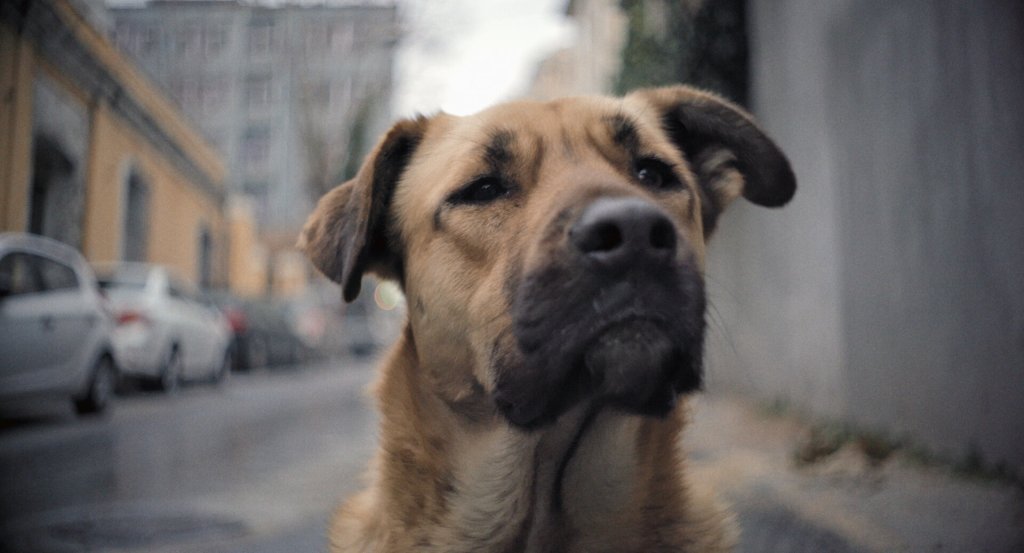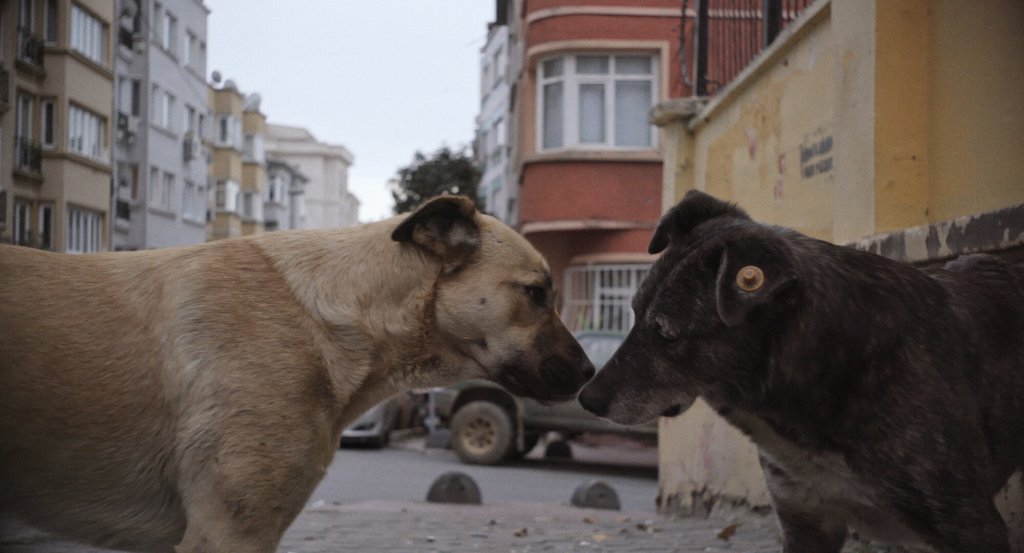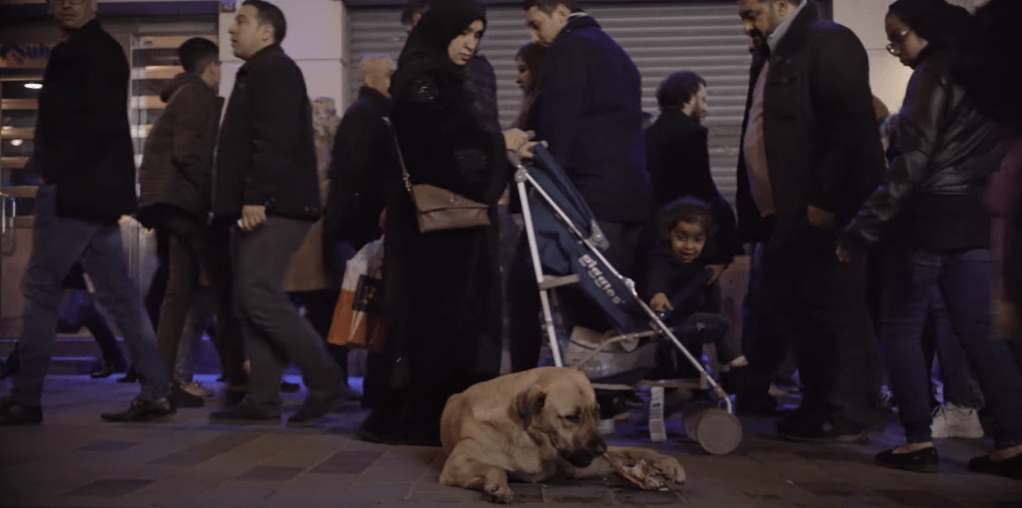
In the documentary “Stray,” writer/director Elizabeth Lo follows the stray dogs of Istanbul, where dogs and cats roam free in the streets.
Unlike the documentary, “Kedi,” which was about the cats of Istanbul, Lo doesn’t interview any of the local people about their views on the stray population. She keeps the film entirely dog-centric, thanks to well-placed mikes and GPS trackers. But the film ends up being about more than just the dogs themselves: It’s also about the people they bond with, some of whom are also homeless.
The canine star of the film is Zeytin (Turkish for “Olive”), a female lab mix who knows the streets well but always remains independent. There’s also Nazar, who’s more approachable, and puppy Kartal (whose name means “Eagle” in Turkish), whom a trio of homeless Syrian refugees try to adopt.
Somewhat like Disney’s Tramp, these dogs are known by different names to different people and have their favorite spots to beg for treats. But there’s no cruel dog-catcher trying to trap or kill any of these dogs. They live their lives undisturbed on the streets of Istanbul.
Moviepaws talked to Lo about making the film, how deeply the people of Istanbul care about the stray dogs, and whether that kind of system could work anywhere else.

Moviepaws: Did you go to Turkey and were inspired there to make a movie about the stray dog population, or did you go there specifically to make this movie?
Elizabeth Lo: I went to Turkey to make this movie. I had this idea to do a global study of comparing the status of dogs in different cultures, just to show how arbitrary it is, the value that we assign to a single species. I read about the history that Istanbulites had with stray dogs and the really radical and progressive laws that they have now, where you’re not allowed to kill any healthy stray dogs or hold any in captivity. Imagine passing those laws in America. So I was really struck by that and I went there and I started filming.
Moviepaws: How did you choose Zeytin as the main dog to focus on for your film?
Elizabeth Lo: She was running past me with Nazar in this really busy underground tunnel. She was running with such a sense of purpose. I was like, “What appointment does a stray dog have to keep?” It felt like that “Alice in Wonderland” moment where you’re chasing the White Rabbit. We met Zeytin and she was on the heels of the young Syrian men who are part of the film. Their relationship was really beautiful and moving to me. They found warmth and a sense of belonging and home in each other, despite the men being displaced.
Zeytin herself, she was the only dog that we filmed with who didn’t inadvertently follow us back. A lot of dogs that we tried to film with, they would end up following us back after they got to know us. That kind of defeated the purpose of the film, which was to let go of my human desires and will and control of the story and to give it to a non-human will and see where a dog would take you. Zeytin was one of the only dogs who could fulfill that promise. She had friends throughout the city, but often she was solitary. She would pick who to hang out with.
Moviepaws: Was it hard to get the trust of the young men to film them, even when they were doing drugs?
Elizabeth Lo: It was really easy in a way because we shared this love of Zeytin and Nazar, the two dogs who were primary members of the makeshift family on the streets. Because the film was about dogs and I told them the film was about the dog hears and sees and smells around them, they were really into the idea. Jamil [one of the Syrian refugees] is obsessed with dogs. Those young men are constantly trying to acquire more dogs. I think it comes from this deep place of wanting to grow your pack. When you’re feeling a little bit insecure, dogs provide that sense of security. It was really easy and they were really welcoming to me. Even though I didn’t speak any Turkish and we couldn’t fully understand each other. I always had co-producers with me who navigated that relationship.
Moviepaws: How hard was it to get a tracking device on the dogs?
Elizabeth Lo: We knew that we needed to find some way to track them, because at the end of our shoot day, how would we find them the next morning? We were sponsored by this company called Tractive GPS. They have these tiny little GPS trackers that you can clip onto a collar. I remember when I would first try to put the collars on the dogs, bystanders would come up to us really alarmed, saying, “What are you doing? These dogs belong to the community, they belong to the streets. You can’t do things to them.” I was really struck that people cared so much about every single stray dog in that city. If you tried to hurt them or take them away, people would stand up for them.
But eventually we were able to get trackers on dogs. So overnight, we could see where the dogs were. There’s one instance where when we finally found Zeytin, through the tracker, she was surrounded by police and men because the tracker was beeping because the battery was dying. People were worried that it was some kind of bomb and that Zeytin was a vessel for a terrorist attack! Of course, we dispelled that, but it was one of those really strange and surreal moments of production. But Zeytin was just completely calm. Just laying on the ground, like, “What are you guys all freaking out about?” It’s something that I love about dogs, how they ground you.

Moviepaws: Although the film is centered on the dogs, you do get snatches of human dialogue and some of the local human activity as well in Istanbul, including a women’s demonstration and the plight of these Syrian refugees. So the movie ends up being a snapshot of what’s going on politically in Istanbul as well. Is that something you had intended to include in the film?
Elizabeth Lo: Yes, I was interested in seeing what the world or society liked from the most peripheral and marginalized and potentially dispossessed viewpoint you could find. I think the concept of following a stray dog around … they’re occupying public spaces, so the people the stray dogs encounter are either people relegated to public spaces or people fighting for their rights in public spaces, like the women. Or making a living on the streets, like the musicians. Or in the case of Zeytin and Istanbul at the time, where there’s this huge influx of refugees. It was almost inevitable that this relationship with the young men would become a part of the story. I would have to intentionally turn away from those issues to avoid that.
Moviepaws: Not everyone in Istanbul seems to love the dogs: Some of the food vendors in the film didn’t seem very fond of them.
Elizabeth Lo: There may be people who are a little less tolerant of the dogs, but the extent of that would be shooing them away. The people in Istanbul establish the boundaries that they have with the dogs, so the dogs are incredibly well socialized. They know how to read people so well, how close they can get, how much they can beg for food, based on the person’s tolerance of them.
Moviepaws: Some of the dogs have tags on their ears. Does that mean they are being tracked by the government?
Elizabeth Lo: The tags are a sign that the dogs have been vaccinated. So every dog that has been vaccinated for rabies and all those other diseases are put back on the track so that people know. You’ll actually see in the film — because I filmed at different times over the course of three years — that are some shots where Zeytin has the tag and some where she doesn’t.
Moviepaws: Is it possible to just take one of the stray dogs home with you if you want to? What’s the protocol?
Elizabeth Lo: I’m not totally sure of the legal parameters. Like, shelters cannot have street dogs languish in cells if they’re healthy. Only sick street dogs or problem dogs are put in shelters there. If you worked very hard to tame a street dog and wanted to adopt it, I’m sure nobody would stop you. But I think you wouldn’t think to do that because the dogs are so sustained so well within the city. Also, I don’t think they would be used to being a pet. It would be a difficult transition. Every time I tried to put a collar and a leash on Zeytin, she would just sit down and refuse to move, because she was so alarmed by her body being controlled by somebody else. That’s something I really respected about her.
Moviepaws: With this film, are you trying to advocate for the kind of “no kill, no shelter” system Turkey has in other countries like the U.S.?
Elizabeth Lo: Yeah, I want this film to function as a decolonizing tool, to sort of undo our cultural assumptions that cities and countries that have really huge stray dog populations are not taking care of their animals when it’s the exact opposite. Where we’re from [the U.S.], dogs are being killed every day and languishing in cells. They could be living such rich lives every day, like you see in ‘Stray.’ I don’t know how feasible it is. I feel like once a society has turned their backs on stray dogs, it’s hard for people to come around to the idea that they’re not actually a problem. If you just opened your mind to allowing dogs to not be persecuted and policed just because they’re a dog, that dogs can exist outside of the property/pet paradigm.
Moviepaws: Do you know where Zeytin is now?
Elizabeth Lo: I was worried when the pandemic hit. As Istanbul went into lockdown, I wondered, “What happens to all these stray animals who survive off the scraps of people going out to restaurants?” I was really heartened to hear on the news and from my local producers that the government has been making a lot of effort in feeding the stray animals by setting out kibble every day. Also, people volunteer to do that. That came as no surprise to me, I believe that Zeytin is fine, because Zeynep Köprülü, one of my producers who lives in Istanbul, occasionally will send me pictures of Zeytin sleeping in her usual spots. I have full faith that she is doing well.
Moviepaws: And what about Kartal, the puppy?
Elizabeth Lo: Kartal is one of those sad moments in production where I have no idea where Kartal is or what happened to him. We searched every shelter and we asked the police about what happened, because we know they took him in. So we think that a police officer took Kartal home. I don’t know for certain. I suspect that. We had a lot of ethical debates about whether to intervene and how to intervene and was it our place to. But before we could make a decision, the police stepped in.
Moviepaws: Are you still in touch with the young men in the movie?
Elizabeth Lo: No, because they don’t have cell phones. And I don’t speak the language. But my producer will sometimes still see them in the usual places where the dogs hang out.
“Stray” is now available on VOD on Vudu, Amazon, Google Play and YouTube.










I shed tears at the end of the movie. It is enlightening to know that these dogs are not seen as threats but as what they are, companions.
LikeLike
Such a gentle and beautiful documentary, made me feel happy to see Turkey’s attitude towards these beautiful animals.
LikeLike